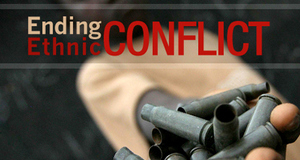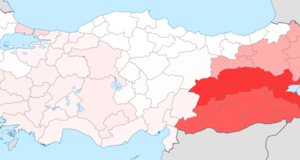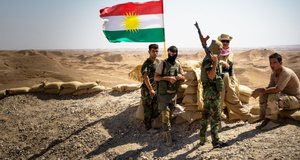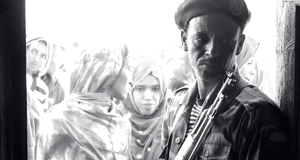Comparing the Roots of Conflict in Europe, the Middle East, and Africa
By
2016, Vol. 8 No. 04 | pg. 1/2 | »
IN THIS ARTICLE
AbstractIn public discourse, Africa and the Middle East have become synonymous with ethnic and religious conflict, whereas Europe is known as a bastion of peace and stability. But are areas known for their ‘high conflict’ truly more susceptible to regional conflict compared to the more 'peaceful' regions? Our findings indicate that the Middle East and North Africa are not as susceptible to the conflicts previously mentioned. We instead propose a more complex view of conflict, where ethnic and religious conflict occur in most regions and factors such as the Cold War in Europe and the existence of holy sites in the Middle East must be taken into account when considering regional conflict. IntroductionAn understanding of regional conflicts, including their causes and legacies, is necessary for cultural, historical, and political literacy. In spite of globalization and the increasing reach of conflict, the majority of wars are fought between states that share borders and are a part of the same geopolitical region. Given that every region contains different ethnic, linguistic, and religious groups, as well as various resource factors that could potentially act as flashpoints for conflict within the region, why is it that some regions have become bywords for regional and ethnic conflict, while others have become bywords for regional peace? What causes bordering states or neighboring groups to engage in conflict with one another sometimes and resolve issues peacefully at other times? We argue that differences in identity do not cause conflict by themselves, but war is more likely when two countries have populations with different identities than it is when they have similar identities.Material conflicts did not consistently correlate with one another, but identity factors such as language, ethnicity, and religion consistently correlated with conflict. This indicates that differences in identity lead to violent conflict more consistently than material factors. Differences in identity lead to violent conflict more consistently than material factors. However, the data do not suggest that identity itself is the cause of conflict on a regular basis. The case of the strategic site--a location with both material and cultural significance--illustrates that the combination of material motivation and differences in identity is particularly volatile. Strategic sites correlated with more conflicts than any other factor studied, and their prevalence in the Middle East has contributed to its instability. Though states will rarely go to war simply because of identity differences, their presence makes war more likely, making strategic sites the “perfect storm” of regional conflict. Literature ReviewGenerally speaking, there is a large amount of literature in regards to the types of conflict we are researching. In regards to resources in particular, there is debate on whether abundance or scarcity cause conflict. According to Maxwell and Reuveny (2000), conflict arises over resource scarcity, or when there is a severe lack of natural resources1. Brunnschweiler et al. (2009) supported this, claiming that resource wealth actually decreases the chances of conflict, and this correlation works vice versa2. In regards to ethnic conflict, Gurr (1994) writes that many believe that ethnic conflict is emphasized because it is primordial in nature3. But, there has been a positive trend of ethnic conflict over time, which causes Gurr to further research into ethnic conflict. He argues that ethnic conflict has been nudged by the end of the Cold War, the fragmentation of ethnic groups, and the emergence of religious nationalism4. In regards to water conflicts, areas such as lakes, rivers, and trade ports are often the subject of conflict5. These conflicts can often occur when there is interference, such as a dam upriver, that could cause loss of water for those downriver6. Additionally, the use of rivers and oceans for trade can often lead to conflict, such as control over ambiguously held bodies of water such as seas and large lakes7. In regards to oil conflict, Cotet and Tsui (2013) find that oil conflict is emphasized after the great increase in the importance in oil in the world8. However, in their study, they find that, when one controls for several interfering variables, the relationship between oil and conflict became insignificant9. Middle EastThere is a variety of literature in regards to the origins of conflict in the Middle East. In Lewis (2007), the author claims that “Contrary to the general impression which prevails, the Arab-Israeli dispute is not the main world issue in the Middle East. It is basically a local issue, a conflict between local interests”10. Other scholars, such as such as Sørli et. al. (2005) disagrees with this, arguing that in the Middle East itself, ethnic violence is indeed significant11. They also find that there is indeed greater conflict in the Middle East than in any other region12. The importance of oil is also the subject of debate among scholars. Kliot (1994) argues that “the Center for Strategic and International Studies predicts that water, not oil, will become the dominant subject of conflict for the Middle East by the year 2000. Rapidly growing populations, ambitious development programmes and the prolonged droughts of 1989 have accelerated this transformation” (Water Resources and Conflict in the Middle East 1994, 12).13 However, Sørli et. al. found in their statistical analysis that there was no correlation between conflict in oil, thus contesting these claims14. After further examination, we found that water conflict, especially surrounding the three major rivers -- the Nile, the Tigris-Euphrates and the Jordan river -- was a large predictor of fighting (Sorli 2005, 1). Interestingly, we also found scholarly predictions that the effects of climate change will, in the near future, potentially play a very important role in the fight over resources -- and not just water. Middle Eastern countries already compete for access to water, simply because the area is mostly arid, desert land. However, the International Institute for Sustainable Development (IISD) also predicts that “climate change may intensify food insecurity, thereby raising the stakes for the return or retention of occupied land” (Brown and Crawford 2009, 2).15 Similarly, the authors of chapter four of Rand Corporation’s Sources of Conflict in the Greater Middle East write, “water is already an increasingly prominent issue in the security perceptions of regional states (as in other instances of resource “vulnerability,” perceptions can be as important as reality in driving the actions of states)” (Lesser, Nardulli and Arghavan, 204).16 Like the IISD, this report suggests that conflicts over resource security may play a greater role in the Middle East in the years to come. While our data only shows correlation and not causation, we cannot confirm this idea. Still, in the decades to come, it will be interesting to see whether these predictions are fulfilled. Finally, we found scholars that credit Middle Eastern conflict to migration, ethnicity and religion. “The growth of Islamist movements and the possible rise of new Islamic regimes will have potentially important implications for conflict within and among Middle Eastern societies, as well as between the Muslim world and the West. Where violent Islamist movements exist but cannot easily triumph, as in Algeria, the stage may be set for prolonged strife affecting regional balances and the ability of states to clash or cooperate with the West”17. The chapter goes on to explain that the rise of these regimes has the potential to drive many people into less extreme, neighboring states. While the Assad family in Syria is not religiously extreme and thus does not completely fit this explanation, Syrian migrants present a great problem, not only to surrounding countries but to the rest of the world. The Syrian civil war has also led to the rise of the Islamic State, a deeply Islamist regime that is proving to be a very dangerous adversary. Due to the fact that the Islamic State has only become powerful in recent years, it is too early to see exactly the effects it will have upon conflict and instability in the Middle East. However, it may well be that in the next few decades, Islamic extremism becomes a greater source of conflict. Huntington (1996, 253) argues that in the Middle East, Islam is the problem, claiming that “Islam’s borders are bloody, and so are its innards18.” However, Sørli et al. (2005) has found that this is not the case, failing to find any significance between conflict and Islam19. AfricaIn regards to Africa, there is additionally great debate regarding whether Africa is more prone to conflict. Henderson (2009, 25-58) argues that “nevertheless, the view of African politics -- and its conflicts -- as simply chaos, 'greed' and/or warlord driven has not gone unchallenged; further, such perspectives ignore the functional aspects of even problematic features of African politics.”20 Other authors argue that the causes of conflict in Africa can be attributed to causes inherent in all societies. For example, El-Ayouty and Zartman (1984) claim that:
While resource and political conflict play a large role in instability in Africa, ethnicity and identity play even a larger role, which ultimately leads to boundary conflict. A large amount of this conflict is caused by “ethnic overhang,” which occurs when an ethnic group is bisected by a national border, thus splitting the group but creating two countries. Colonialist powers, much like the French and British in the Middle East, did not care about the indigenous African population when they were creating state borders. Thus, many ethnic groups have been split, which leads to the groups trying to annex territory from a neighboring state in order to unite the group. Understandably, this leads to conflict:
Because these borders were arbitrarily created, there is little sense of national identity. African people often hold onto their ethnic origins, despite their official nationalities, with politicians even doing the same. “Political leaders and grassroots militants alike defaulted from their national identity to their ethnic identity. Political rivalries became ethnic conflicts.”23 It can be understood that although political rivalries and border conflicts do factor into African instability, the underlying roots of conflict come from identity and ethnicity issues. However, some scholars dispute this claim. Smith and Kay (2000, 32) found that, while ethnic tensions and conflicts are indeed prevalent, the existence of a liberal democracy can often lead to lesser ethnic conflict24. This is because, if a country has greater civil liberties, its citizens can express themselves in a constructive manner and not resort to violence25. Additionally, Lesser et al. argues that Africa’s regional conflict have been heavily influenced by the introduction of superpowers into conflicts, who saw their conflicts as proxy wars against other major superpowers26. EuropeIn Europe, there is a variety of debate regarding the greatest source of conflict. Oudernam argues that ethnicity seems to be the greatest driving factor of conflict. In chapter five of Rand Corporation’s Sources of Conflict in Europe and the Former Soviet Union, John Van Oudenaren writes, “In many parts of Central, Eastern, and Southeastern Europe, the presence of ethnic or religious minorities in states dominated by other ethnic or religious groups creates a potential for subnational conflict.”27 He goes on to explain that minorities such as the Hungarians in Slovakia and Serbia, the Turks in Greece and the Greeks in Albania all look for protection from their mother country, but given that they reside in these other countries, there is not much their mother country can do. For many, Oudenaren argues, this is where the seeds of conflict arise. However, from this, he says, neighboring countries engage in territorial dispute as can be seen in the “conflict between Greece and Turkey -- over territorial issues in the Aegean, over Cyprus, and over minority issues in Thrace”28. Fox (2001, 464) disagrees, finding that other regions such as the Middle East are more prone to ethnic conflict compared to Europe29. Ethnicity and identity are not the only factors that cause conflict in Europe, though. Oudenaren and other scholars blame the breakup of the former Soviet Union (FSU) for much of Europe’s issues. Oudenaren writes,
The collapse of the Communism also had profound effects on these states and their problems have yet to be resolved. Thus, there appears to be more conflict in Europe than originally assumed, perhaps inhibiting it from being the “gold standard” many believe it to be. Fox additionally found that the Cold War, which gripped Europe from 1945-1991, prevented ethnic conflict and instead caused civilizational conflict30. MethodologyBecause our initial question -- what causes regional conflict -- was so broad, it was necessary to distinguish between forms of regional conflict. Initially, we divided conflict into three wide types: resource conflict, identity conflict, and political conflict. We then further subdivided these categories. For the purposes of this paper, resource conflict includes conflict over natural resources, geographical advantage, and borders. Identity conflict refers to conflicts in which combatants were of different races, ethnicities, language groups, or religions. Political conflict indicates conflict over the form of government or leader in a country; many of these conflicts take place during the Cold War and refer explicitly to conflict between USSR-backed and US-backed factions. After dividing these forms of conflict further, we coded for the presence or absence of each type of conflict, ranging from conflict over land to conflict between different linguistic groups. Typically, there were at least three forms of specific conflict present in each conflict (for example, conflict over a port could include conflict over a strategic site, water access, and border conflict). Because the focus of our analysis was regional conflict, we only studied conflicts in which both belligerents were from the region where the conflict was located. For example, a conflict between Jordan and Lebanon would qualify as a regional conflict in the Middle East, while a conflict between Egypt and the UK would not be included in our analysis. Due to the breadth of the topic, we also only studied conflicts since 1900. We began our analysis with a focus on the Middle East, known as a hotbed for regional conflict, and expanded it to include Africa and Europe for comparison. We chose these three regions because of the range of potentially confounding variables--such as poverty, natural resources, and system of government--and because of the disparity between their reputations in relation to conflict. The Middle East and Africa are often regarded as two of the most conflict-prone regions in the world, whereas Europe has a reputation as a “gold standard” in democracy, low crime rates, and stability. By comparing the three regions, we aimed to elucidate whether or not certain regions were more prone to regional conflict, or identity conflict in particular. For comparison, we ran four Pearson’s R analyses: one for the Middle East, one for Africa, one for Europe, and a cumulative analysis with the data from all three regions. We began our research by using the Polynational War Memorial’s archives to find a list of every conflict with over 1,000 battlefield deaths by region in the twentieth and twenty-first centuries. The Polynational War Memorial is a Swedish source that documents conflicts that meet the international threshold of “war.” We decided to use this threshold because virtually all conflicts that meet the threshold for “war” are considered regionally and historically significant, whereas conflicts with fewer deaths vary in their significance and memory. Additionally, the international standard was appealing because it is frequently agreed upon by scholars. The Polynational War Memorial listed nineteen regional conflicts for Europe, twenty for Africa, and 34 for the Middle East since 1900, and a brief summary of each conflict that includes dates, locations, belligerents, and factors in the conflict, when available. After obtaining the data, we sorted conflicts by the presence or absence of identity conflict and resource conflict, and by the specific types of conflict present. When we were finished, we had accounted for ten different types of conflict: political/regime, water, land, strategic site, oil, border, race, religious, ethnic, and linguistic. As many of these types of conflict are present in one conflict, the majority of conflicts were coded under multiple categories. For example, the Yom Kippur War was categorized as land, site, border, religious, ethnic, and linguistic conflict. Unfortunately, it was impossible to prioritize which factors were more or less important in a conflict. Once we had categorized the data, we coded it for presence or absence with dummy variables (0 for absent, 1 for present) and processed the data with SPSS. We chose to use Pearson’s R for this analysis. Though linear regression is more predictive than Pearson’s R, it does not work as well on dummy variables. We ran four Pearson’s R analyses: one of all the data and one for each region. This analysis tested all variables against all other variables, so we could establish correlations between any type of conflict and any other. In Pearson’s R, significance is present when there is five percent or less error. In this paper, we will indicate when data has less than five percent error. Anything deemed insignificant has six percent or greater error. FindingsOur findings indicated an increase in several types of conflict when belligerents were of different ethnicities, languages, or religions. These identities were not separate phenomena; more often than not, groups that went to war with one another differed on more than one of these factors (for example, two warring ethnic groups also held different religious beliefs). Generally speaking, the fewer identity characteristics groups had in common, the more likely war became. This is true across regions, though some regions saw different identity factors at play than others. In Europe, for example, all wars occurred between Christian-majority countries, so there was no religious conflict to observe. Likewise, in the Middle East, there were no interracial conflicts due to the composition of the region, but ethnic conflict (between Jews and Arabs in particular) was common. Regardless, the principle of “the more different the people, the more likely the conflict” holds in all three areas studied. The aforementioned volatility of strategic sites is an interesting case that highlights regional variation. Overall, strategic sites correlate with conflict over water, border control, religion, ethnicity, and language. However, the influence of strategic sites varies considerably by region. In the Middle East, strategic sites correlate with linguistic, religious, and border conflict. The conflicts that fall into this category in this region refer exclusively to religious sites, particularly those in Israel. Because these are repeated conflicts over the same area that occur between the same states, they are a case study in the overlap of identity difference and conflict (the Israelis are Jewish and speak Hebrew; the Arab League represents Arabs who speak Arabic and practice Islam). In Africa, strategic sites are much less volatile. They correlate only with conflict over water, and represent only five conflicts since 1900. Likewise, in Europe, strategic site conflict correlates with conflict over water, but it also correlates with ethnic and linguistic differences. Thus, the compounded identity differences as well as material incentives (water) make strategic sites problematic in Europe. Conflict over exclusively materialist or identity factors is relatively rare across regions, according to our data. Most materialist conflicts--those over water, land, or oil--correlated rarely and sporadically with other factors. Border conflict, like strategic sites, appears to be a hot-button issue as another intersection of materialist concerns and identity division. Identity factors are much strongly correlated with conflict. This supports our hypothesis that countries with similar identities are less likely to engage in war. Regional variation is important in this observation, as the most volatile identities are not the same worldwide. For example, European conflict has no history of racial or religious tension, but virtually all conflicts occurred between linguistically different countries. In the Middle East, religion is a dominant factor in conflict. Thus, our data indicate general, cross-regional principles, but they cannot override the nuances of area variation.Continued on Next Page » Suggested Reading from Inquiries Journal
Inquiries Journal provides undergraduate and graduate students around the world a platform for the wide dissemination of academic work over a range of core disciplines. Representing the work of students from hundreds of institutions around the globe, Inquiries Journal's large database of academic articles is completely free. Learn more | Blog | Submit Latest in Political Science |


















